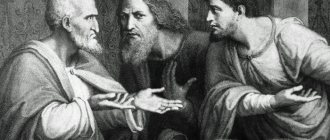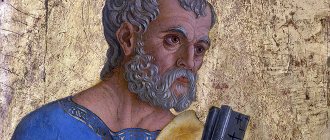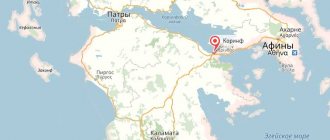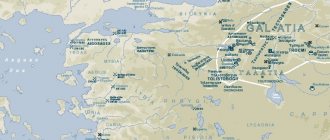Relics of St. Apostle Paul
The relics of St. were discovered in a tomb in a Roman basilica. Apostle Paul. Believers have long been convinced that under the altar of St. Paul's Basilica, “what is outside the walls,” his relics are kept.
According to legend, the body of the Apostle, after his martyrdom in 65, was buried in the catacombs along the Appian Way, and then transferred to the church consecrated in his honor. In 2006, Vatican archaeologists discovered a stone sarcophagus, after examining which they were able to confirm that the relics belonged to the Apostle.
Rome, June 29, 2009. The relics of the supreme apostle Paul have been discovered in Rome, Pope Benedict XVI announced Sunday evening. The pontiff said that for the first time in history, a scientific study of the sarcophagus located under the altar of the Roman temple, whose full name is St. Paul's Cathedral outside the city walls, was recently carried out. In the sarcophagus, never before opened for centuries, the slightest hole was made to insert a probe, through which traces of precious linen cloth dyed purple, a plate of pure gold and blue cloth with flax fibers were discovered. The presence of red incense, as well as protein and calcareous compounds, was also detected. In addition, tiny fragments of bones were found, which were examined using carbon-14 by experts who did not know about their origin. According to the results, they belong to a person who lived between the 1st and 2nd centuries. “All this fills our soul with deep feelings,” emphasized the head of the Roman Catholic Church.
A marble sarcophagus with the inscription “Paul the Apostle, martyr” was discovered by archaeologists as a result of lengthy excavations in the Roman Basilica of St. Paul "Outside the Walls". Scientists tried to take an X-ray of the coffin “to see what was inside,” but the stone walls of the sarcophagus were too thick. In addition, in order to open the supposed coffin of St. Paul, the scientists needed permission from Pope Benedict XVI. According to legend, the Apostle Paul was executed in Rome and buried on Via Ostiense outside the city walls. A small church was erected at the burial site at the beginning of the 4th century, and at the end of the century - a basilica of impressive size. Over the past centuries, the Basilica of St. Paul's is the largest church in Rome after St. Petra has been rebuilt many times. With each such reconstruction, the sarcophagus with the remains of the Apostle dropped lower and lower compared to the floor level, and as a result of the last reconstruction in 1823, it was 1.3 meters lower. Currently, most of the sarcophagus is still covered with a layer of limestone, but a window was made in the floor of the basilica through which believers can see the tomb of the Apostle. HISTORICAL REFERENCE. Saint Paul originally bore the Hebrew name Saul. He was a Roman citizen and a persecutor of the Christian faith. One day he was illuminated by a bright light, from which he fell blind to the ground. A voice came from the light: “Saul, Saul, why are you persecuting Me?” To the question “Who are you?” The Lord answered: “I am Jesus, whom you are persecuting.” And he ordered to go to Damascus. Saul's companions heard the voice of Christ, but did not see the light. In Damascus, the blind Saul was taught faith and on the third day he was baptized by Ananias. At the moment of immersion in the water, Saul received his sight. From that time on, he became a zealous preacher of the previously persecuted teaching. And he took the name Paul. Subsequently, he preached at the court of Emperor Nero and even converted his beloved concubine to faith in Christ. For this he was put on trial and, after a nine-month imprisonment, beheaded with a sword - as a Roman citizen. IDENTIKIT. German criminologists took part in an unusual investigation: they compiled an identikit of a man who lived 2000 years ago and was well known in the Christian religion under the name of the Apostle Paul. The unusual experiment was timed to coincide with the Year of Paul, declared by Pope Benedict XVI. Experts solved the puzzle with the help of documents provided by the theologian from Düsseldorf Michael Hesemann, who is engaged in the biography of the apostle. Hesemann collected numerous materials: historical sketches, data on Paul’s age, marital status, as well as a description of signs made in the 2nd century. Paul's history, including his travels in the eastern Mediterranean, is documented almost without gaps. The documents handed over to experts helped to recreate the real appearance of the apostle. Experts posted the results for free access to the Internet. According to the results of the investigation, Pavel turned out to be a bow-legged man of small stature, fair-skinned, with pronounced bald patches on his forehead. He had a beard, black with noticeable graying, a hooked nose and almost fused eyebrows. The sharp, chiseled features of the face and, first of all, the large brown eyes catch the eye. A similar middle-aged man could be found on the streets of any city in southern Europe.
Holy places of Rome associated with the life of the Apostle Peter
Church of St. Peter the Apostle on Janiculum Hill. It stands on the spot where the Apostle Peter was crucified. Considering himself unworthy even in death to be like his Divine Teacher, the Apostle Peter asked to be crucified upside down. The request was fulfilled: on June 29, 67, the Apostle Peter died a terrible, painful death. Before his death, St. Peter with St. The Apostle Paul was kept in the Mamertine prison, from where both apostles were simultaneously taken out for execution by order of Emperor Nero. The large church (first mentioned in the 8th century) is called “on the Golden Mountain” - the hillock of the Janiculum Hill on which it stands is called the “Golden Mountain” because of the golden color of the sand. Pay your attention to the small church, which stands on the very site of the crucifixion of St. Petra, it is a true masterpiece of Renaissance architecture. Cathedral of St. Apostle Paul on the Ostian road. The Ostian Cathedral (“outside the city walls”) stands on the burial site of St. Paul the Apostle. In its present form, the basilica was rebuilt by the architect Poletti under Pope Pius IX and consecrated in 1854. After the Vatican Council of St. Peter's, this temple is the largest church in Rome. In the tomb under the main altar of the cathedral, there are the relics of St. Apostle Paul. Here, in the lower aisle, the relics of St. Apostle Timothy. The Apostle Timothy was a disciple of the Apostle Paul, who wrote two letters to him in Ephesus, where he was a bishop and where he died a martyr around 97. In the church of St. of the Apostle Paul, the great disciple and after death remains at the feet of the great teacher - this is not the only example: in the Holy Trinity Sergius Lavra to the ancient Trinity Cathedral, the tomb of St. Sergius of Radonezh, adjacent to the south is the Nikon chapel, the tomb of his beloved disciples, St. Nikon of Radonezh. Church in the name of St. Apostle Paul "at the Three Fountains". Built on the site where the Apostle Paul was executed on June 29, 67. At the site of the execution of St. Paul was kept in the dungeon for a short time, after which he bowed his head under the sword; the severed head hit the ground three times and in three places of contact with the ground three springs, or three fountains, gurgled. The church got its name from these three fountains, which have not dried up to this day. Also kept here is the pillar on which the Apostle Paul was beheaded by the sword. Lateran Cathedral and St. Prophet, Forerunner and Baptist of the Lord John This is one of the most ancient churches of Christianity. Today the Lateran Basilica of St. John the Baptist is the cathedral of Rome. The cathedral received its name from the Lateran Palace, and the palace, in turn, took its name from the consul Plautius Lateran, to whom it originally belonged. The Lateran Palace, with a basilica erected next to it, was the first official residence of the popes. After the fires that devastated it in the 14th century, the Lateran Cathedral was rebuilt. The silhouette of the temple is visible from any elevated point in Rome. The main facade of the basilica, added in 1755, is considered the most beautiful in Rome. The main altar is covered by a canopy (ciborium), in its upper part the heads of the holy apostles Peter and Paul are kept. The cathedral houses one of the greatest shrines of Christianity - the sacred meal, or tabletop, on which the Savior celebrated the Last Supper with His disciples. Then the Lord established the sacrament of the Eucharist (Greek - “thanksgiving”), which is celebrated today in every Orthodox church in the world during the Divine Liturgy. According to the predictions of the saints, while this is taking place, the world will stand, its cessation will mark its end - the time of the Last Judgment will come. The Lateran Cathedral also houses the plaque on which the Apostle Peter and the first Roman bishops celebrated the Divine Liturgy. Church "Holy of Holies" with the Holy Staircase. Here is the Holy Staircase, brought from Jerusalem, from the house of Pontius Pilate. While the residence of the popes was the palace at the Lateran Cathedral, this temple was their home church. The Holy Staircase leads to the Holy of Holies church from the main entrance. The Savior ascended and descended along this staircase four times: upon his arrival to Pilate; when He was led from Pilate to Herod; upon his return from Herod to Pilate and when He went from Praetoria to be crucified. Pilgrims climb the Holy Staircase only on their knees. Cross-shaped holes were made in the boards covering the steps in places where drops of the Savior's blood fell on the steps. Here are numerous relics and the ancient Jerusalem image of the Savior, secretly sent from Constantinople to Rome during the period of iconoclasm (8th century). Church in the name of the Honest and Life-Giving Cross of the Lord. This church was built to store Jerusalem's shrines. Thanks to St. Equal to the Apostles Helen, Rome became the richest repository of gospel shrines in the world. This church was built for them, which is also called the Church of the Holy Cross of Jerusalem. The Cathedral of the Holy Cross with the chapels of the Passion of the Lord and Equal-to-the-Apostles Helen is called the “Roman Jerusalem”. We recommend that you visit it; it is one of the most revered and visited by pilgrims. The basilica was built by St. Constantine in 330, it was rebuilt in its modern form in the middle of the 15th century. St. Helena brought here from Jerusalem a part of the Life-Giving Tree with a title (inscription) on it, earth from Golgotha and other shrines. In 326, the Life-Giving Tree of the Holy Cross was found by St. Elena, who went to Jerusalem for this. Three identical crosses were found on Calvary; it was not possible to determine on which of them Jesus Christ was crucified. A funeral procession passed by the excavation site and it was decided to place all three on the dead man one by one. The deceased was resurrected when the Cross was laid on which the Savior was crucified. At the same time, a title or inscription was found on the Cross, made by Pontius Pilate: “Jesus of Nazareth, King of the Jews.” The temple also contains a large part of the cross of the prudent thief. He confessed the Lord on the cross and was the first of the people to follow Him into paradise; his prayer to the Crucified One, “Remember me, Lord, when You come in Your Kingdom,” became the favorite prayer of Christians and one of the most beautiful hymns of the Orthodox Great Lent. The temple contains many shrines, incl. finger of St. Apostle Thomas - the finger he placed in the wounds of the Lord. St. Thomas is one of the 12 apostles, who, with his “unbelief,” foreshadowed the appearance of the risen Christ to His twelve disciples and, by touching the wounds of the Savior, testified to the reality of the resurrection. The Apostle Thomas preached in Parthia, Media and India, where he died as a martyr. Here are kept: one of the nails of the Holy Cross, two thorns from the Crown of Thorns, sacred stones from the Bethlehem Cave, from the Holy Sepulcher and from the Column of Flagellation. Church of St. Apostle Peter "in Verigi". The chains of St. Peter the Apostle are kept in it. It is located on Exvilina Hill near the Church of Our Lady of Maggiore. Faith of St. Peter's are the chains in which the apostle was chained for preaching Christ - the first time in Jerusalem by order of Herod, the second time - in Rome, in the Mamertine prison, by order of Nero. Church “Where are you going, Lord?” At the place where the temple stands, the Lord Jesus Christ appeared to the Apostle Peter. When St. The servants of the angry Nero were looking for Peter for execution; Christians begged the apostle to leave Rome for the benefit of many. The Apostle did not agree, wanting to die for Christ. Having bowed, however, to the prayers of the entire community, St. Peter left the city at night, after the conciliar prayer. When he was at the city gates, he saw Jesus Christ coming towards him with a cross on his shoulders. Having bowed to Him, St. Peter asked, “Where are you going, Lord?” (Domine, quo vadis?) “I’m going to Rome to be crucified again,” the Lord answered him and became invisible. The apostle realized that Jesus was willing to suffer again, this time with him, in his body. The Apostle returned to Rome, was arrested, imprisoned in Mamertine and then crucified. On the walls of the temple, the faces of the Savior and the Apostle Peter are depicted on opposite sides. Between them on the floor lies a stone on which traces of two human feet are carved. This is a copy of the original stone on which, according to legend, the Lord stood during his conversation with the Apostle Peter. Church in the name of the Hieromartyr Clement, Pope of Rome. While examining this temple, you will be able to trace from its example not only the features of the layout of ancient Christian churches, but you will also be to a certain extent privy to the life of contemporary Christian communities. The church was built on the site of a house that belonged to St. Clement. Atrium (inner courtyard) - in the ancient Church, penitents of the first category stood here during services, “crying” or “wintering”, because stood in the open air. The porch (porch), where the catechumens of the “second class”, the “listeners” stood. A catechumen is a member of the community, a neophyte who has not yet received St. baptism, unable to begin the Sacraments of the Church. In the modern Orthodox Liturgy (at the end of its 1st part, the so-called Liturgy of the Catechumens), the deacon’s exclamation “Come out, ye catechumens!” has been preserved, i.e. “Unbaptized and second-class repentants, leave the temple!” The church is a basilica, i.e. a rectangle divided by colonnades into three naves (ships). The right nave was for men, the left for women. In the modern Greek Orthodox Church this custom is strictly observed to this day. In the middle (main) ship there was a “choir”, a place for deacons, subdeacons, readers and singers. The altar is separated from the rest of the church by a marble partition. Behind the altar there is a bishop's pulpit, on both sides of it, along the wall of the altar, there are benches for priests. The temple contains the relics of the Hieromartyr Clement, the Pope and the Hieromartyr Ignatius the God-Bearer. According to legend, St. Ignatius was the child to whom the Lord pointed to His disciples with the words: “If you do not turn and become like children, you will not enter the Kingdom of Heaven.” Later he was a disciple of St. John the Evangelist, then was Bishop of Antioch. St. Ignatius became the first Christian martyr to be killed in the Colosseum. Hieromartyr Clement came from a line of ancient Roman kings and was a disciple of the Apostle Peter, who baptized him. Subsequently St. Clement becomes Bishop of Rome (91-100). Together with other Christians, he buried the Apostle Peter in the Vatican Catacombs in 67. During the persecution under Emperor Domitian, he was exiled to the most remote part of the empire, to the quarries of the Crimea. While imprisoned in Tauride Chersonese, he converted the pagans to Christ with preaching and miracles, for which he was drowned, by order of Trajan, in the Black Sea (101). Chersonesos is located not far from present-day Sevastopol; St. was baptized here in 988. Equal to the Apostles Grand Duke of Russia Vladimir. In the crypt under the temple is the original basilica of St. Clement, it was once the resting place of St. Equal to the Apostles Cyril, teacher of Slavic. The holy brothers Cyril and Methodius, educators of the Slavs, were the children of a noble and wealthy Greek nobleman from the Byzantine city of Thessalonica (Slav. Thessalonica). They created the Slavic alphabet, translated the Holy Scriptures and liturgical books from Greek into the Slavic language, and introduced worship among the Slavs in their native language, for which they suffered a lot of trouble from the Latin clergy. St. Cyril died in Rome on February 14, 869. Church in the name of the Mother of God “on the Broad Road” On this place stood the house in which, according to legend, the Apostle Paul lived. The church got its name, “on the Broad Road,” from the location: in ancient times in Rome there was a whole quarter that was called “The Broad Road.” Above the main altar stands an ancient miraculous icon of the Mother of God, according to legend - one of those painted by the Apostle and Evangelist Luke. Go down to the lower church; According to legend, it was built on the site where the house was located in which the Apostle Paul lived in custody during the first Roman two-year imprisonment. The powerful preaching of the apostle, wise by divine grace and one of the most educated people of his time, even reached the royal palace; even some courtiers and relatives of Nero turned to Christ. Here, together with St. Paul spent some time with St. Apostle and Evangelist Luke, apostle of the 70; The Apostle Paul calls him in one of his letters “the beloved physician.” Here around St. Paul's disciples gathered, here he wrote his letters to other communities. In the lower church you will also see the source of water miraculously produced by the Apostle Paul, in which he baptized converts and the column to which St. Paul was chained. Apostle Paul. Church in the name of the Mother of God “Altar of Heaven” Here, according to legend, Emperor Augustus talked with the prophetess Sibyl, who foreshadowed to him the Nativity of the God-Man within the boundaries of his empire. He saw in the sky the image of the Most Pure Virgin with the Child of God, knelt before him and renounced the title “divine” assigned to him by the Roman Senate. Augustus created an altar to the Unknown God on this site, which was called the Altar of Heaven. The Temple of Maria in Aracheli stands on the top of the Capitoline Hill. Already in the 6th century, this church was known as the Church of Santa Maria de Capitolo, i.e. Our Lady of the Capitoline. In this temple there is a chapel of St. Equal to the Apostles Queen Helena, mother of St. Equal-to-the-Apostles Constantine, in whom her relics rest. St. Helena fostered in her son a love for Christ and was a zealous helper in his deeds for the benefit of the Church. She personally worked in places consecrated by the feet of the God-man, found the Life-giving Sepulcher of the Lord and the Precious Cross of Christ and built many churches in the Holy Land, especially in those places that are associated with the events of the earthly life of Jesus Christ. She died in 335 at the ripe old age of 80, shortly after returning from Jerusalem. Above the main altar there is an ancient miraculous icon of the Mother of God, according to legend - one of those painted by St. the Apostle Luke. Church in the name of the Mother of God “New”. A relic is kept here that will tell you the completion of the dramatic story, the beginning of which is narrated in the Gospel, in the “Acts of the Apostles.” The temple is located on the Roman Forum from the side of the Colosseum (10th century, rebuilt in the 13th century). It was called “New” until the 15th century. (today better known as the Church of Francis of Rome). Above the main altar of the temple is an ancient Byzantine icon of the Mother of God (5th century). The New Testament, in the Acts of the Apostles, tells about Simon the Magus, who hypocritically accepted baptism and wanted to buy the gift of the Holy Spirit with money, i.e. the ability to heal and perform miracles, but was rebuked by the Apostle Peter. He repented, as is related below, but his repentance was obviously again hypocritical. A stone with traces of human feet, embedded in the wall to the right of the entrance to the temple, will tell you about the ending of this story. Above it is an inscription in Latin: “On this stone St. knelt. Apostle Peter at the time when demons lifted Simon the Magus into the air.” The disgruntled psychic went to Rome and was going to amaze the people by ascending to heaven, but, through the prayer of the Apostle Peter, he collapsed to the ground. Our contemporary, Hieromonk Seraphim (Rose), tells a similar case: an Indian fakir who performed “miracles” was put to shame by a certain monk who witnessed them. When he began to read the Jesus Prayer to himself, the miracles stopped and the fakir fainted. Christian Byzantines, instead of asking each other “how are you doing,” asked each other the question “how is your Jesus Prayer?” — I wonder how many modern lovers of “mysterious” healing and astonishment for money would lose their income if Christians resumed this custom? Jesus Prayer: “Lord Jesus Christ, Son of God, have mercy on me, a sinner!” Chapel of St. Apostle and Evangelist John the Theologian “in Olei” Built on the site of the torture and execution of St. John, after which he remained unharmed. Here, according to legend, St. John the Theologian, the beloved disciple of Christ, brought in chains from Ephesus, endured torture, drank a cup of poison without any harm to himself and was thrown, by order of Emperor Domitian, into a cauldron of boiling oil (oil). He came out of there completely unharmed, after which he was exiled to the island of Patmos. There, on the island, he wrote the Fourth Gospel and the Apocalypse (Greek - “Revelation”)
Description
From the outside, San Paolo Fuori le Mura resembles an ordinary fortress, but the main decorations are located inside. The interior of the Cathedral is richly decorated in the style of classicism and neoclassicism. There are three doors leading into the basilica, each of which is decorated separately.
The right door contains plates from an ancient door that stood until the 19th century. Not far from them is an image of the resurrection of Christ.
There are 5 halls inside the cathedral, the central one is divided into parts by 80 granite columns. The colonnade and ceiling fresco date from the 19th century. The ceiling is decorated with carved gilded panels. The cathedral has also preserved part of the 5th century building - fragments of mosaics and an arch. One of the names of this arch is the Arch of Galla Placidia, it is believed that it was erected in honor of the wife of the Roman emperor. Each window has a unique pattern that lets in the sun's rays and fills the cathedral with warm light. The entire floor is lined with images of various animals.
The gallery of San Paolo Fuori le Mura contains portraits of 236 pontiffs. They are arranged in medallions, and there are very few unfilled frames left. There is a legend that when the last Pope dies and all the medallions are filled, the end of the world will come.
Visitors can see the sarcophagus containing the relics of St. Paul in the center - this is the main attraction of the basilica. Above it rises the creation of 1285 - a tabernacle, decorated with skillfully combined pagan and Christian motifs. And next to it stands a 13th-century candlestick, 5.5 m high. Only the Pope has the right to celebrate Mass over the relics.
There are holes in the tomb into which visitors inserted pieces of cloth in order to touch the holy place. Near the sarcophagus there is an altar with a window, which allows any visitor to confess their sins.
The basilica also houses:
- a piece of the Life-giving Cross of the Lord;
- a piece of the staff with which Saint Paul made his journeys on foot;
- particles of the relics of bishops, apostles, martyrs.
In 2011, the cathedral hosted the 10th international festival of sacred music (X° Festival Internazionale di Musica ed Arte Sacra). Symphony No. 7 by Anton Bruckner was performed within the sacred walls by a symphony orchestra.
Opera La traviata in the church
Every Thursday and Saturday in the Church of St. Paul there is an opportunity to enjoy the masterpiece of the genius Giuseppe Verdi - the opera La Traviata. Starts at 20:30, tickets costing from 30 to 50 euros can be bought at the official ticket offices tiquets.com - I recommend going.
- You'll also find our directory of Roman theaters useful.
How to get there
Address: Piazzale San Paolo, 1
San Paolo Fuori le Mura is located in the southern part of the city, two kilometers outside the Aurelian Walls. You can visit the cathedral grounds with a guided tour or on your own. Tourists are provided with the most comfortable conditions possible, they even provide wheelchairs and allow blind people to walk with a guide dog. There are souvenir shops at the entrance to St. Paul's Cathedral.
You can get to the church:
- by metro line B - get off at Garbatella or Marconi stations;
- by bus number 23 or 769 - you need to get to the Via Ostiense-San Paolo stop;
- by tram number 2 - get off at the Basilica S. Paolo stop.






